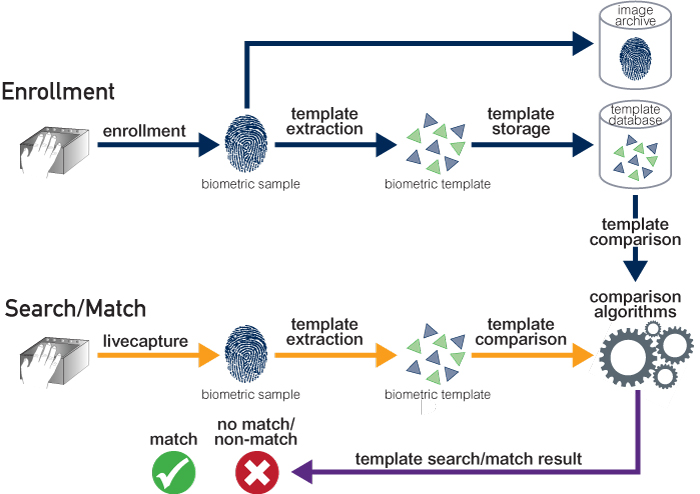Biometric Processes
Biometric systems rely on several discrete processes: enrollment, live capture, template extraction, and template comparison. The purpose of enrollment is to collect and archive biometric samples and to generate numerical templates for future comparisons. By archiving the raw samples, new replacement templates can be generated in the event that a new or updated comparison algorithm is introduced to the system. Practices that facilitate enrollment of high-quality samples are critical to sample consistency, and improve overall matching performance, which is particularly important for biometric identification by “one-to-many” search.
We can differentiate “live capture” from enrollment as the process of collecting live biometric “probe” samples upon an access or identification attempt and comparing them to a “gallery” of previously enrolled templates.
Template extraction requires signal processing of the raw biometric samples (e.g. images or audio samples) to yield a numerical template. Templates are typically generated and stored upon enrollment to save processing time upon future comparisons. Comparison of two biometric templates applies algorithmic computations to assess their similarity. Upon comparison, a match score is assigned. If it is above a specified threshold, the templates are deemed a match.
Typically, biometric template extraction and comparison algorithms are proprietary (different and secret) and so can’t be used with those from different vendors in the same system (e.g. to compare templates generated by different products, or use a matching algorithm from one company to compare templates generated by algorithms of another). Exceptions are MINEX-certified, minutiae-based fingerprint template generators and matching algorithms. This category of templates and matchers have been specifically designed, tested, and independently certified by NIST to be interoperable for one-to-one verification and so are ideal for compact storage on smart cards or travel documents.

Figure 1. A biometric process